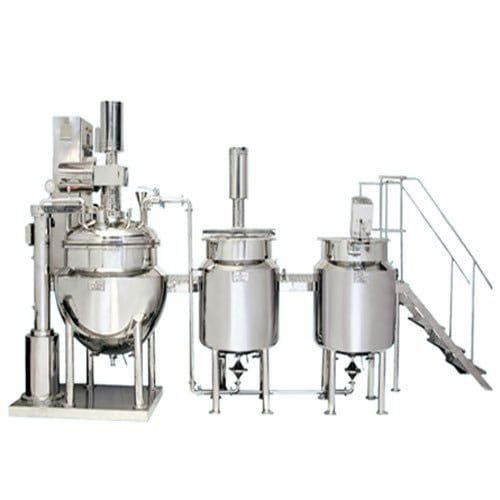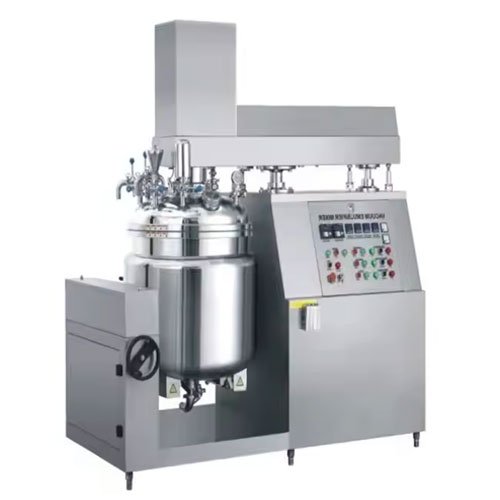An Ointment Manufacturing Plant is an advanced setup designed to produce ointments, creams, gels, and lotions efficiently and hygienically. It is widely used in the pharmaceutical, cosmetic, and personal care industries. This article explores the components, functionality, benefits, and considerations for designing and operating such plants. Ointments and creams are semi-solid formulations consisting of active ingredients mixed with a suitable base. The process involves emulsifying, homogenizing, and blending oil-based and water-based ingredients to form a stable and uniform product. To achieve consistent quality, specialized equipment and controlled processes are essential.
An Ointment Manufacturing Plant is an essential setup for producing high-quality ointments, creams, and gels. With advanced equipment, automation, and adherence to hygiene standards, these plants ensure efficient production, meeting industry and regulatory demands. Whether for pharmaceuticals, cosmetics, or personal care, the design and functionality of the plant play a crucial role in delivering consistent and reliable products.
Key Components of an Ointment Manufacturing Plant |
| 1 | Vacuum Homogenizer Mixer | |
| Functionality | The core of the plant, responsible for emulsifying and homogenizing ingredients |
| Features | Agitator for uniform mixing.
Vacuum system to remove air bubbles.
Heating and cooling jackets for temperature control.
Homogenizer for achieving fine particle size and texture |
| 2 | Water Phase Vessel | Used for heating and dissolving water-soluble ingredients.
Equipped with a jacket for precise temperature control |
| 3 | Oil/Wax Phase Vessel | Melts waxes and heats oil-based components.
Prevents contamination and ensures uniform melting |
| 4 | Storage Vessels | Stores finished ointments temporarily before the filling process.
Often equipped with agitators to maintain consistency |
| 5 | Transfer Pumps | Transfers the product hygienically from the homogenizer to storage or filling machines.
Common types include lobe pumps and diaphragm pumps |
| 6 | Filling and Sealing Machine | Automated or semi-automated machines for filling the final product into tubes, jars, or bottles.
Can include tube crimping or bottle capping options |
| 7 | Control Systems | Automated panels to monitor and control parameters such as mixing speed, vacuum pressure, and temperature |
Ointment cream manufacturing plant |
| JSK Engitech is a trusted manufacturer of advanced ointment plants, offering customized solutions for producing a wide range of semi-solid products, including ointments, creams, shampoos, lotions, moisturizers, toothpaste, and more. Our automated ointment and cream manufacturing plants feature three distinct phase vessels: a water phase vessel, a wax phase vessel, and a main manufacturing vessel. These are complemented by essential components such as an emulsifier/homogenizer, vacuum pump, transfer pump, storage and buffer vessels, and a CIP module. All vessels are constructed from SS316L-grade stainless steel, ensuring durability and compliance with cGMP standards. For aseptic manufacturing, the system can be fully automated with pneumatically operated valves, providing precision, efficiency, and reliability. |
Water Phase Vessel |
| The water phase vessel is designed for mixing aqueous phase ingredients with water or a similar solvent. It features a jacket for precise temperature control, allowing for both heating and cooling of the solution. Temperature regulation can be achieved through steam and chilled water or an electrical heating system, depending on the utilities available at the customer’s facility. Equipped with a propeller-type stirrer and baffles, the vessel ensures uniform mixing while preventing vortex formation. For minimal contamination, the vessel is capable of vacuum suction, allowing the product and solid ingredients to be drawn in. Solid ingredients can be introduced through an additive hopper at the top or a suction port at the bottom of the vessel. Once the desired composition is reached, the solution is transferred to the main manufacturing vessel for further processing. |
Wax Phase Vessel |
| The wax phase vessel is specifically designed for blending all oil and wax-phase ingredients, with wax serving as the primary solvent. The vessel features a jacketed design for efficient heating, enhancing wax solubility at elevated temperatures. Temperature control can be achieved through steam and chilled water or an electric heating system, depending on the utilities available at the customer’s site. Equipped with a saw-tooth cutter-type stirrer, the vessel ensures uniform and consistent mixing. It is also capable of vacuum suction to introduce solid ingredients and product, minimizing contamination during the process. Once the desired composition is achieved, the prepared solution is seamlessly transferred to the main manufacturing vessel for further processing. |
Main Ointment Manufacturing vessel |
| The main manufacturing vessel is designed to mix the contents of the water phase and wax phase vessels at precise temperatures, controlled using either steam and chilled water or an electric heating system, depending on the utilities available at the customer’s facility. This vessel is equipped with a top-mounted anchor-type agitator featuring Teflon scrapers to ensure thorough mixing and efficient scraping of material from the vessel walls. For superior emulsification, the vessel includes a bottom-mounted homogenizer capable of achieving a uniform liquid-liquid mixture with particle sizes reduced to less than 10 microns. Once the desired composition and viscosity are achieved, the product is transferred to a storage vessel through a flush bottom diaphragm valve, minimizing product retention in the tank. Automation and Safety
The operations of pumps, pneumatically operated valves (for automated systems), and mixers are managed via a main control panel constructed from SS304-grade material. The panel includes essential safety features, such as an emergency stop and mains supply indicators, ensuring safe operations and extended equipment life. Interconnecting Systems
The vessels are linked with interconnecting pipelines designed in compliance with cGMP standards, connected using sealed tri-clamp fittings to maintain hygiene and prevent contamination. Advanced Ointment Manufacturing Plant
Our ointment and cream manufacturing plant is a cutting-edge solution for producing high-quality semi-solid products with minimal human intervention. Utilizing modern technology and innovative design, our ointment manufacturing equipment is tailored to meet the specific production needs and expectations of our customers, enhancing both performance and efficiency. |
Ointment Manufacturing Process |
| 1 | Raw Material Preparation | Pre-weighing of all ingredients.
Melting of waxes and oils in the oil phase vessel.
Dissolving water-soluble components in the water phase vessel |
| 2 | Emulsification and Homogenization | Both phases are transferred to the vacuum homogenizer mixer.
Mixing and emulsifying occur under vacuum to ensure uniformity and eliminate air |
| 3 | Cooling and Final Adjustments | The product is cooled to the desired temperature using a cooling system.
Final adjustments like pH correction or viscosity adjustments are made |
| 3 | Filtration and Transfer | The product is filtered to remove impurities or particulates.
It is then transferred to storage tanks or filling machines |
| 4 | Filling and Packaging | The finished product is filled into suitable containers.
Labeling and batch coding are performed for traceability |
| Advantages of Ointment Manufacturing Plants |
| 1 | High Efficiency | Automated systems reduce manual intervention and production time. |
| 2 | Quality Assurance | Consistent mixing, precise temperature control, and vacuum processing ensure high-quality products. |
| 3 | Scalability | Available in various capacities to meet small-scale or industrial production needs |
| 4 | Compliance | Designed to meet GMP, FDA, and other regulatory standards |
| 5 | Hygiene | Stainless steel construction and clean-in-place (CIP) systems maintain sterility. |
| 6 | Cost-Effective | Reduced wastage and efficient energy use minimize operating costs |
| Design Considerations for an Ointment Manufacturing Plant |
| 1 | Capacity Requirements | Choose equipment based on expected production volume. |
| 2 | Material of Construction | Use SS316 for product contact parts to ensure compliance with regulatory standards |
| 3 | Automation Level | Decide between manual, semi-automatic, or fully automatic systems based on budget and operational needs |
| 4 | Space and Layout | Ensure adequate space for equipment installation, maintenance, and future expansion |
| 5 | Regulatory Compliance | Design should meet GMP and FDA requirements, including proper documentation and validation |
| Applications |
| 1 | Pharmaceutical Industry | Ointments for burns, wounds, and therapeutic treatments, Antibiotic creams and gels |
| 2 | Cosmetic Industry | Moisturizers, anti-aging creams, and sunscreens |
| 3 | Personal Care Industry | Hair removal creams, medicated lotions, and gels |
Salient Features of Ointment Manufacturing Plants |
| Optimized for Minimal Manpower | The plant is designed to be efficiently operated by just one operator and one helper |
| Automated Material Transfer | Material transfers are conducted using vacuum systems or transfer pumps, ensuring a clean and efficient process |
| cGMP-Compliant Construction | All vessels and components feature paint-free construction to comply with current Good Manufacturing Practices (cGMP). |
| Food-Grade Gaskets | High-quality silicone gaskets (food-grade) are used for all sealing applications. |
| Premium Contact Materials | All contact parts are made of ss316 stainless steel with a smooth mirror finish (class 4B) to ensure crevice-free surfaces. |
| Efficient Agitator and Emulsifier Placement | Agitators are top-mounted. High-speed emulsifiers are mounted either at the bottom or in-line, as per customer preference. |
| Pressure Sterilization Capability | All vessels are built to withstand an internal pressure of 1 Kg/cm², making them suitable for sterilization processes. |
| High-Quality Piping System | All pipes, fittings, and valves are made of seamless SS304 or SS316 stainless steel (as per customer requirements), with internal electro-polished surfaces. Equipped with tri-clover joints for easy assembly, cleaning, and replacement. |
| CIP & SIP Compatibility | The entire plant includes connections for Clean-in-Place (CIP) and Sterilization-in-Place (SIP) systems, ready for integration if these systems are available. |
| Digital Monitoring and Control | Temperature and time values are displayed digitally on the control panel. Ampere meters indicate motor current for real-time monitoring. |
| Customizable Automation | The plant can be upgraded with a microprocessor-based automatic operating system to meet specific customer requirements |
| User-Friendly Connections | All inlet and outlet connections feature tri-clover joints, ensuring easy cleaning, quick disassembly, and hassle-free replacement |









